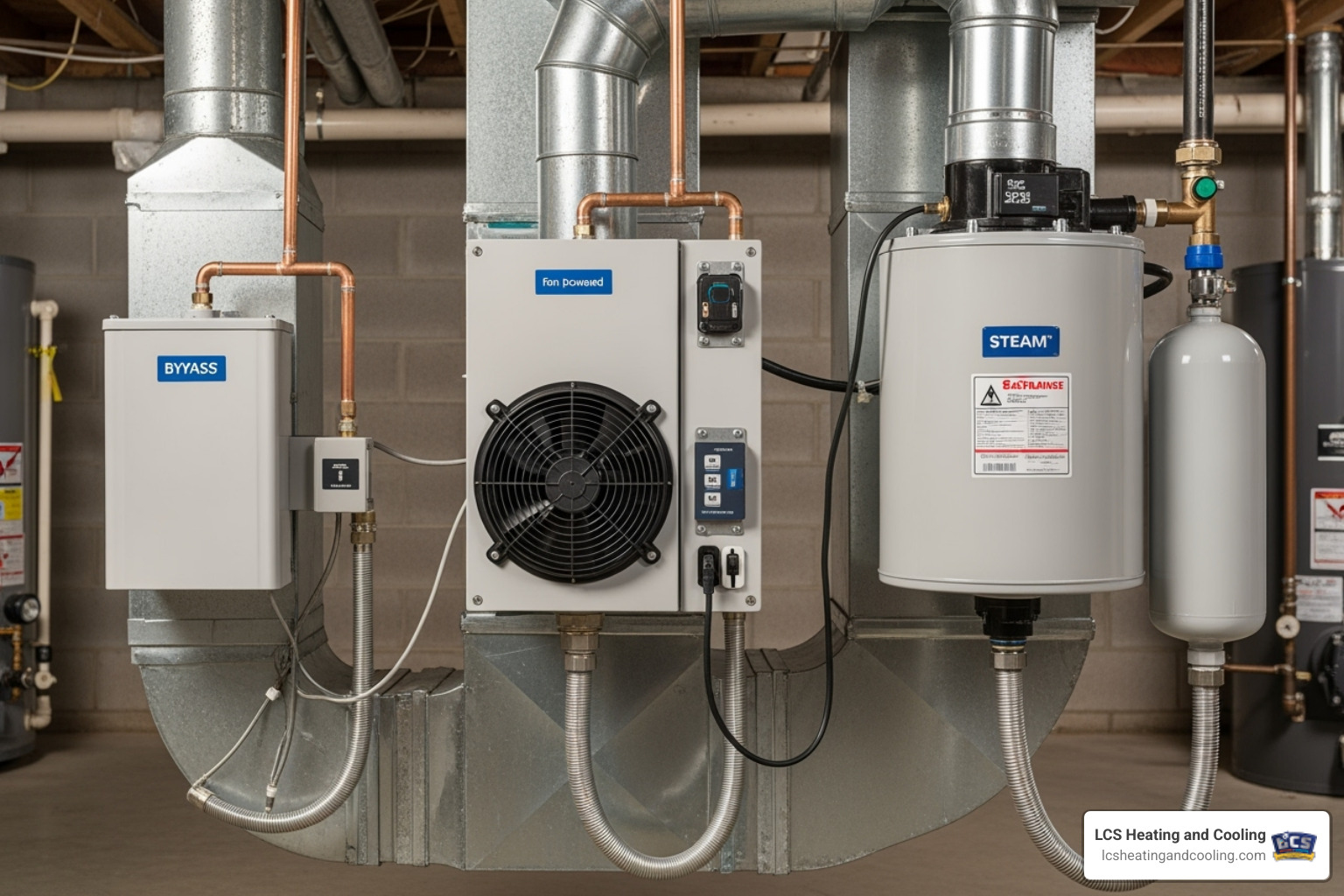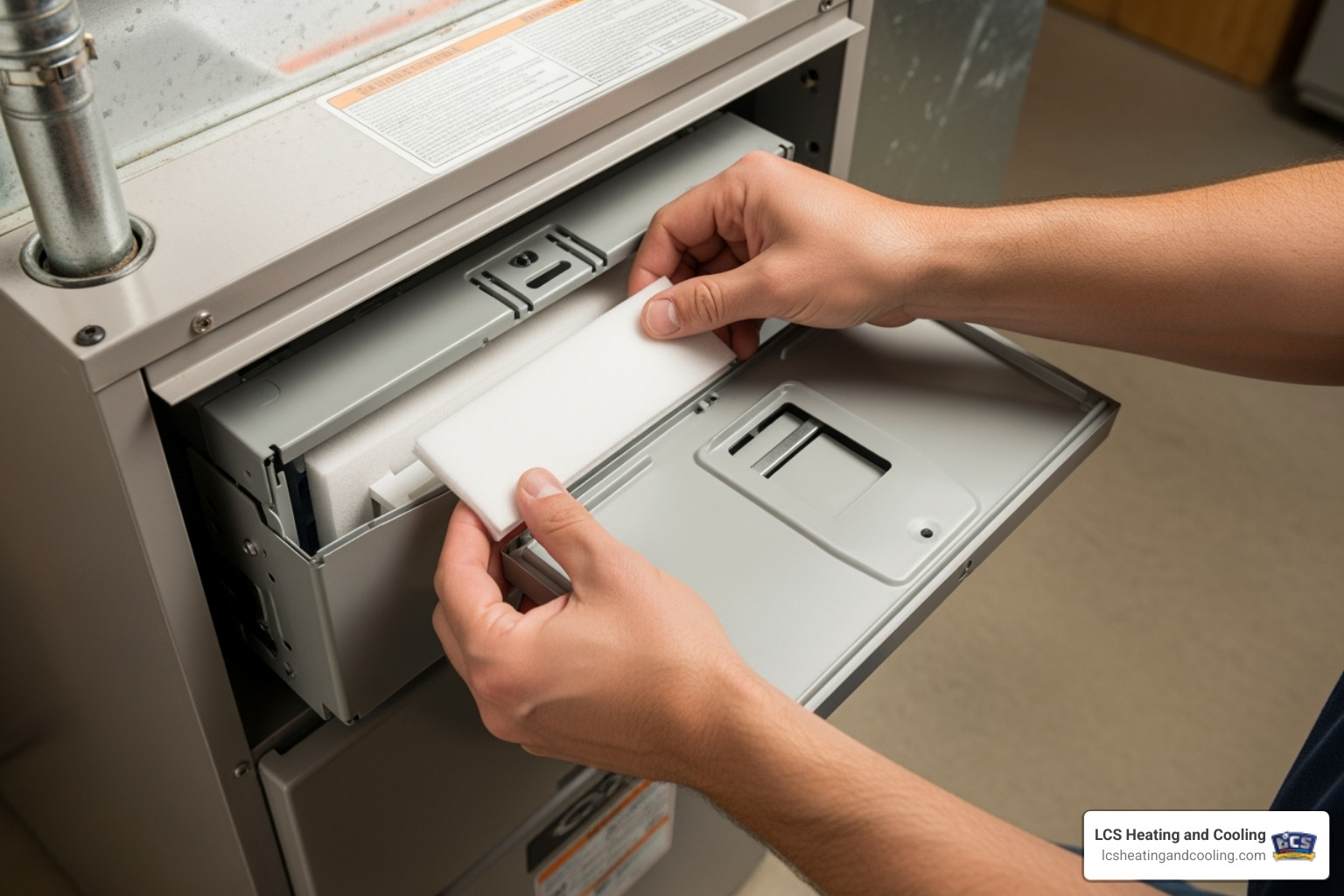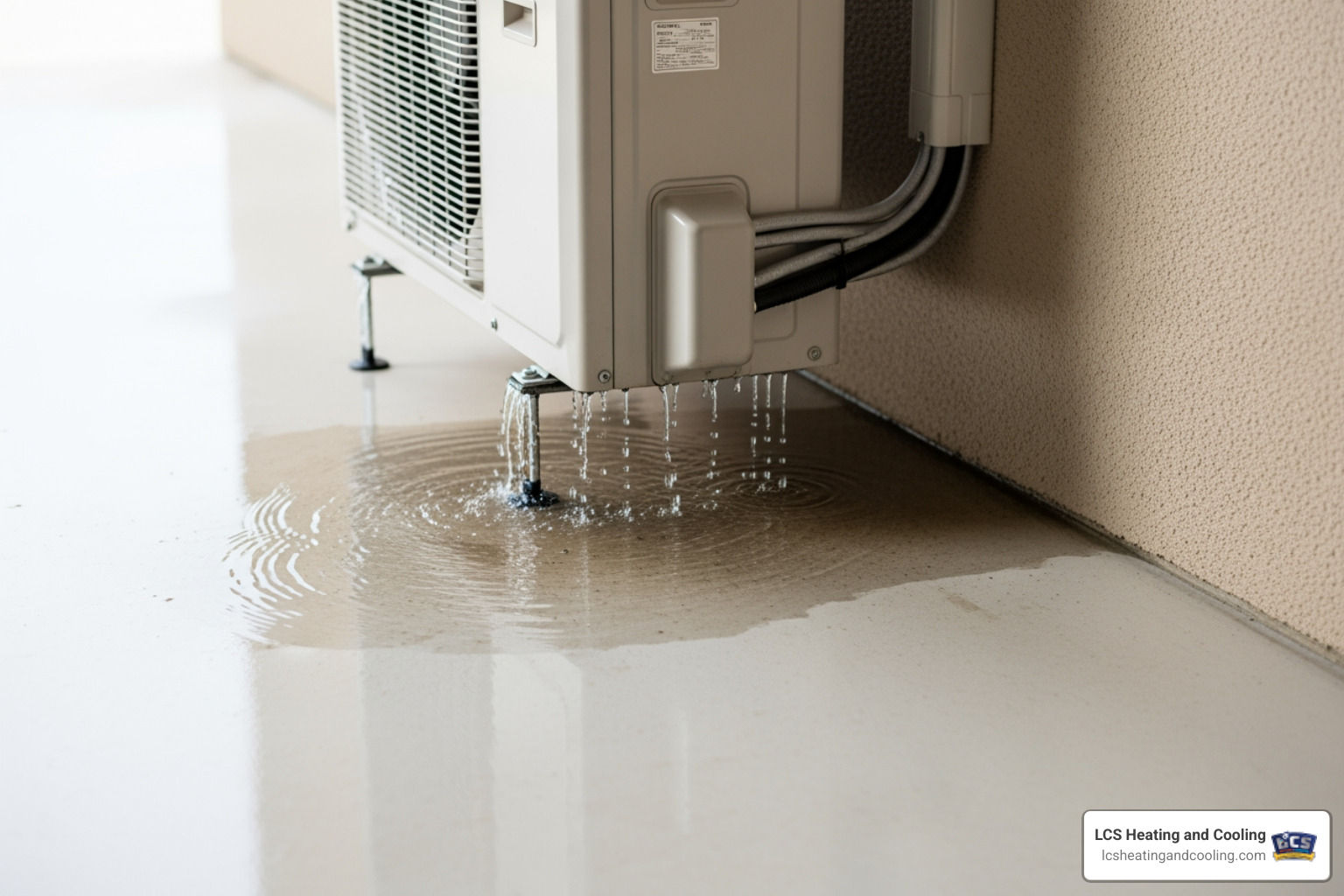Humidifier Harmony: A Step-by-Step Furnace Installation Guide
Why Your Home Needs Balanced Humidity
Furnace humidifier installation can transform your home's comfort during Indianapolis's harsh winter months. When your heating system runs constantly, it strips moisture from the air, leaving you with dry skin, static electricity shocks, and irritated respiratory passages.
Quick Answer: What's Involved in Furnace Humidifier Installation?
- Location Selection - Mount on return or supply air duct near furnace
- Ductwork Preparation - Cut precise openings using manufacturer templates
- Water Connection - Connect to home's water supply via saddle valve or tee fitting
- Electrical Wiring - Wire humidistat to furnace control system
- Drain Installation - Run drain line to floor drain or condensate pump
- System Testing - Check for leaks and proper operation
Here's what dry winter air does to your home and family:
- Health impacts: Dry skin, cracked lips, nosebleeds, and worsened allergy symptoms
- Home damage: Wood floors crack, furniture splits, and paint peels
- Comfort issues: Static electricity builds up throughout your house
- Energy waste: Dry air feels colder, forcing you to turn up the thermostat
A whole-house humidifier works directly with your existing furnace system. As heated air moves through your ductwork, the humidifier adds the perfect amount of moisture before distributing it throughout your home.
Professional installation typically takes 2-3 hours and involves connecting the unit to your water supply, wiring it to your furnace controls, and ensuring proper drainage. While some homeowners attempt DIY installation, the electrical and plumbing connections require specific expertise to avoid water damage or safety hazards.

Explore more about furnace humidifier installation:
Understanding the Benefits of a Whole-House Humidifier
When the cold winds blow and our furnaces are working overtime to keep us warm, the air inside our homes can become incredibly dry. This isn't just an uncomfortable nuisance; it can lead to a host of problems for both our health and our homes. That's where a whole-house humidifier steps in, working in harmony with your furnace to create a more balanced and comfortable indoor environment.
So, can a humidifier be added to an existing furnace? Absolutely! It is 100% possible to integrate a whole-house humidifier into your current furnace system. These units are designed to work in tandem with your existing HVAC setup, making it a feasible and highly beneficial upgrade for nearly any home with forced-air heating.
But what exactly are the benefits of installing a whole-house humidifier? We've seen the remarkable difference it can make:
- Health and Well-being: Dry air can lead to itchy skin, dry eyes, cracked lips, and even exacerbate respiratory problems. By adding moisture to the air, a whole-house humidifier can significantly alleviate these symptoms. Properly humidified homes can also potentially improve sleep quality and ease allergy symptoms, changing your living space into a more pleasant refuge. Maintaining balanced humidity levels can even help deactivate virus particles in the air, contributing to a healthier home environment overall. This can help with itchy skin, dry eyes, static electricity, and respiratory problems.
- Protecting Your Home and Belongings: Our homes, especially those with beautiful wood furnishings, floors, and even musical instruments, suffer in overly dry conditions. Low humidity can cause wood to dry out, crack, and warp. A whole-house humidifier helps to maintain consistent moisture levels, protecting your valuable investments and preserving the integrity of your home's structure and contents.
- Improved Comfort and Energy Savings: Humidified air actually feels warmer than dry air at the same temperature. This means you might be able to set your thermostat a degree or two lower while still feeling just as comfortable, potentially leading to energy savings on your heating bills. Plus, saying goodbye to annoying static electricity shocks is a comfort in itself!
- Improved Indoor Air Quality: Beyond the direct benefits of moisture, optimal humidity levels can also help reduce airborne dust and make the indoor air feel fresher.
A whole-house humidifier works by drawing water from your home's supply line. As your furnace circulates warm air through the ductwork, the humidifier adds a fine mist or vapor to that air. A humidistat, much like a thermostat for humidity, monitors the moisture levels and signals the humidifier to turn on or off, ensuring your home maintains ideal humidity levels, typically between 30% and 50%. This integrated approach means moisture is distributed evenly throughout your entire home, unlike portable units that only affect a single room.
For more insights into creating a comfortable home, explore home comfort with furnace installation.
Choosing the Right Humidifier for Your Furnace
Selecting the perfect whole-house humidifier for your home is a crucial step in ensuring long-lasting comfort and efficiency. It's not a one-size-fits-all situation; factors like your home's size, your furnace's compatibility, and even your preference for maintenance play a significant role. We'll help you steer the options to find the best fit.

When considering a whole-house humidifier, we typically look at three main types: Bypass, Fan-Powered, and Steam. Each has its own method of adding moisture to your air and specific installation and maintenance considerations.
| Humidifier Type | How it Works | Ideal Use Case | Maintenance |
|---|---|---|---|
| Bypass | Uses furnace blower to push air through a moistened pad | Cost-effective for homes with efficient furnaces and adequate space for bypass ductwork. | Regular cleaning of water pan, annual pad replacement. |
| Fan-Powered | Internal fan pushes air through a moistened pad | More efficient for homes with less powerful blowers or limited ductwork access near the furnace. | Annual pad replacement, periodic cleaning. |
| Steam | Boils water to create sterile steam | Best for larger homes (over 4,000 sq ft), homes with inconsistent furnace use, or those seeking sterile humidification. | Annual electrode cleaning/replacement, drain line inspection. |
Bypass Humidifiers
Bypass humidifiers are a popular and often cost-effective choice. As their name suggests, they work by "bypassing" a small amount of air from the supply plenum (warm air) side of your furnace, directing it through an evaporative pad that is constantly wetted by a water supply. This moistened air then flows back into the return air duct (cold air) and is distributed throughout your home by your furnace's blower. They are reliant on your furnace's blower to operate and typically require the installation of a bypass duct between the supply and return plenums.
Fan-Powered Humidifiers
Similar in concept to bypass humidifiers, fan-powered units incorporate their own internal fan. This fan actively draws air through the moistened evaporative pad and pushes the humidified air into your ductwork. Because they have their own fan, they can add moisture more effectively, even when your furnace blower isn't running at full speed. They don't require a bypass duct, making them a good option for homes with limited space around the furnace or those seeking slightly more efficient humidification.
Steam Humidifiers
Steam humidifiers are the most advanced and often the most powerful option. These units actually boil water to create pure, sterile steam, which is then introduced directly into your home's ductwork. Since they generate their own steam, they are independent of your furnace's heat or blower cycle, allowing for precise humidity control even when the furnace isn't actively heating. They are known for providing the fastest humidification and are an excellent choice for larger homes or those with specific health needs, as the boiling process eliminates bacteria and minerals. While typically a larger investment, their efficiency and performance are best.
A Guide to Professional Furnace Humidifier Installation
Installing a whole-house humidifier is a complex task that involves working with your home's HVAC system, plumbing, and electrical components. While some DIY guides might make it seem straightforward, we strongly recommend professional furnace humidifier installation. The precise details required for proper functioning, coupled with potential safety hazards, make it a job best left to experienced technicians.
Why trust us for your furnace humidifier installation? DIY attempts can lead to:
- Water Damage: Improper plumbing connections can result in leaks, causing significant water damage to your furnace, ductwork, and home.
- Electrical Hazards: Incorrect wiring can damage your furnace's control board, lead to electrical shorts, or even create a fire hazard.
- Voided Warranties: Many furnace and humidifier manufacturers' warranties can be voided if the installation is not performed by a certified professional.
- Inefficient Operation: An improperly installed humidifier may not distribute moisture evenly, leading to inconsistent humidity levels and wasted energy.
- Furnace Damage: Incorrect placement or integration can put undue strain on your furnace, potentially shortening its lifespan.
At LCS Heating and Cooling, our skilled HVAC specialists handle every aspect of the installation with expertise and diligence, ensuring efficient and effective operation. We understand the intricacies of different furnace systems and humidifier types. For more on ensuring a smooth installation process, check out our guide on furnace installation dos and don'ts.

Let's walk through the general steps involved in a professional furnace humidifier installation:
Step 1: Selecting the Optimal Location
The placement of your humidifier is crucial for its functionality and efficiency. Our technicians will carefully inspect your furnace and ductwork to determine the best location.
- Supply vs. Return Air Duct: Most furnace-mounted humidifiers are best placed on the return air duct, close to the furnace. This allows the humidifier to add moisture to the air before it's heated and distributed throughout your home. However, some bypass humidifiers might be installed on the supply air duct. The exact site may vary based on your furnace design and the specific humidifier model.
- Proximity to Water Supply and Drain: The humidifier needs a continuous water supply and a drain for excess water. We ensure the chosen location allows for easy and secure connection to an existing water line and a nearby drain (like a floor drain or condensate pump).
- Clearance from Other Components: We always ensure adequate clearance from other HVAC components, such as AC coils, to prevent interference and allow for future maintenance.
Step 2: Preparing the Ductwork and Mounting the Unit
Safety is our top priority. Before any work begins, we shut off the furnace power to prevent accidents.
- Using a Template: Manufacturers typically provide templates for cutting the necessary holes in the furnace's plenum or return air duct. Our technicians use these templates to mark the precise locations.
- Cutting Precise Openings: We carefully cut openings into the ductwork. An opening is needed for the humidifier to access the home's air supply, and additional cuts are made for parts like the humidistat. These cuts must be precise to ensure the humidifier parts are secure and to prevent air leaks, which would compromise system efficiency.
- Securing the Mounting Plate: Once the cuts are made, the humidifier's mounting plate is attached to the ductwork using sheet metal screws, ensuring a tight and secure fit.
Step 3: The Professional Furnace Humidifier Installation Process
This is where the magic happens, connecting all the necessary components for seamless operation.
- Wiring the Humidistat: The humidistat, which controls the humidifier, is typically installed on the cold air return at least 1 foot above the humidifier. We carefully wire the humidistat to the humidifier, ensuring all electrical connections are safe and secure.
- Connecting to the Furnace Control Board: The humidifier needs to be integrated with your furnace's control system to work in tandem. Our experts connect the humidifier's wiring to the furnace's low voltage control board, ensuring proper communication and operation. Some units may require a step-down transformer (120v to 24v) for electrical connections.
- Tapping into the Water Line: A steady water supply is essential. We connect the humidifier to a nearby hot or cold water pipe using a saddle valve or a tee fitting, depending on local codes and the best practice for your home. This connection must be done securely to avoid any water leaks.
- Installing the Solenoid Valve: The solenoid valve regulates the water flow into the humidifier based on signals from the humidistat. We attach the humidistat wiring to the solenoid valve, ensuring correct electrical and plumbing connections.
- Running the Drain Line: Excess water from the humidifier needs to be safely removed. We install a drain line, routing it to a suitable drainage point, such as a floor drain or a condensate pump, preventing water accumulation and potential damage.
- Testing the System: Once all connections are made, we reassemble the humidifier and carefully test the entire system. We turn on the water and electricity, check for any leaks, ensure the humidifier activates correctly with the furnace, and verify that the humidistat is accurately reading and controlling humidity levels. This final test ensures your new humidifier is working perfectly.
The entire process, from evaluation to testing, is handled by our experienced technicians, making the installation process a breeze for you.
Post-Installation: Humidifier Care and Maintenance
Congratulations! With your new whole-house humidifier installed, you're well on your way to a more comfortable and healthier home. But just like any other home appliance, your humidifier needs a little tender loving care to perform at its best and last for years to come. Proper maintenance is key to preventing issues like mold, avoiding water damage, and extending the unit's lifespan.

Setting Your Humidistat
One of the most important aspects of humidifier care is setting your humidistat correctly. The optimal humidity level for comfort and health is typically between 30% and 50%. However, this can vary based on outdoor temperatures.
- Adjusting for Outdoor Temperature: During very cold weather, it's often best to set your humidistat slightly lower (e.g., between 30% and 35%) to prevent condensation on windows and other cold surfaces. If you notice condensation forming, simply lower the humidistat setting.
- Preventing Condensation: Condensation can lead to moisture buildup, which, if not managed, could potentially encourage mold growth in ducts or on surfaces. By maintaining recommended humidity levels, especially relative to the outdoor temperature, you create a balanced environment. While whole-house humidifiers are unlikely to cause mold in ducts with proper installation and maintenance, setting the humidistat correctly is a crucial preventative measure.
Routine Maintenance Tasks
Regular maintenance will keep your humidifier running efficiently and effectively. We recommend the following routine tasks:
- Replacing the evaporator pad annually: For bypass and fan-powered humidifiers, the evaporator pad (also known as a water panel or filter) collects mineral deposits from the water. Replacing it once a year, usually at the beginning of the heating season, ensures optimal moisture output and prevents mineral buildup. If you have hard water, you might need to replace it more frequently.
- Cleaning the water pan: For bypass drum units, regular cleaning of the water pan is essential to remove sediment buildup and prevent the growth of bacteria or mildew.
- Inspecting the drain line: Periodically check the drain line for any blockages or kinks that could prevent proper drainage. A clogged drain line can lead to water overflow and potential damage.
- Checking for leaks: Occasionally inspect the humidifier and surrounding connections for any signs of water leaks. Early detection can prevent costly water damage.
- Annual professional inspection: We recommend an annual inspection by a professional HVAC technician. During this visit, we can perform a thorough cleaning, check all components, ensure electrical and plumbing connections are secure, and make any necessary adjustments to keep your humidifier running smoothly.
Following these maintenance tips will help ensure your humidifier performs optimally for its full lifespan. For more comprehensive maintenance insights, refer to our furnace installation key steps.
Frequently Asked Questions about Furnace Humidifier Installation
We often hear similar questions from homeowners considering a whole-house humidifier. Here are some of the most common inquiries, answered with our expertise:
Is it difficult to install a furnace humidifier yourself?
Installing a furnace humidifier is generally considered an intermediate-level DIY project. It involves several distinct skill sets:
- Ductwork modification: You'll need to cut precise holes in your furnace's sheet metal ductwork, which requires specialized tools and careful measurements.
- Plumbing connections: The humidifier needs to be connected to your home's water supply, typically through a saddle valve or tee fitting, and a drain line must be run. This requires knowledge of plumbing techniques to prevent leaks.
- Electrical wiring: The humidistat needs to be wired to the humidifier and integrated with your furnace's low-voltage control system. This requires basic electrical knowledge and strict adherence to safety protocols.
While it's possible for a skilled DIYer to tackle this, there are significant risks involved. Improper installation can lead to water damage, unsafe electrical situations, and potentially damage your furnace itself. Furthermore, manufacturer warranties on both your furnace and the new humidifier might be voided if the installation isn't performed by a certified professional. For these reasons, we highly recommend professional furnace humidifier installation to ensure safety, proper operation, and warranty compliance.
Do whole-house humidifiers cause mold in ducts?
This is a common concern, but rest assured, with proper installation and maintenance, whole-house humidifiers are highly unlikely to cause mold in your ducts. Mold requires two things to thrive: moisture and a food source.
- Proper Installation: A professional installation ensures the humidifier is correctly sized for your home and integrated into your HVAC system, preventing excessive moisture.
- Proper Maintenance: Regular cleaning and replacement of the humidifier pad prevent mineral buildup and bacterial growth.
- Setting Humidistat Correctly: As we discussed, setting your humidistat to the recommended levels (typically 30-50%, adjusting lower in very cold weather) prevents over-humidification, which could lead to condensation and damp conditions.
If a humidifier malfunctions or is improperly used, it could contribute to dampness. However, this is not a normal occurrence. By adhering to our maintenance guidelines and setting your humidistat appropriately, you can enjoy the benefits of humidified air without worrying about mold growth in your ductwork.
How long does a whole-house humidifier last?
With proper care and regular maintenance, most whole-house humidifiers are designed to last anywhere from 12 to 15 years. The lifespan can vary depending on several factors:
- Usage: How often and for how long the humidifier runs each year.
- Water Quality: Homes with very hard water may experience more mineral buildup, which can affect components over time if not regularly cleaned. Installing a water softener can help extend the life of your humidifier in such cases.
- Maintenance: Consistent adherence to the recommended maintenance schedule (pad replacement, cleaning, inspections) significantly contributes to a longer lifespan. Neglecting maintenance is the quickest way to shorten your unit's life.
- Quality of Installation: A professional installation ensures all components are correctly fitted and functioning optimally from day one, setting the stage for long-term reliability.
Regular professional servicing can also help identify and address minor issues before they become major problems, ultimately extending the life of your whole-house humidifier.
Conclusion: Achieve Total Home Comfort with Expert Help
Bringing balanced humidity into your home through furnace humidifier installation is more than just a home improvement; it's an investment in your family's health, comfort, and the longevity of your home itself. We've explored how these integrated systems combat the harsh effects of dry winter air, protecting your skin, alleviating respiratory issues, preserving your wooden furnishings, and even helping you save on energy bills.
From understanding the different types of humidifiers to navigating the intricacies of installation and the simplicity of ongoing maintenance, we hope you feel empowered with knowledge. While the benefits are clear, the installation process requires a skilled touch, involving careful work with your HVAC system, plumbing, and electrical components.
That's where we come in. At LCS Heating and Cooling, we pride ourselves on our "7-Star Concierge Service." This means we're committed to making your furnace humidifier installation a seamless and stress-free experience. Our certified technicians provide prompt, clear communication and a streamlined process, ensuring you are informed and respected every step of the way. We handle all the complexities, from selecting the optimal location to carefully connecting every wire and pipe, so you can simply relax and enjoy the lasting comfort solutions we provide.
Ready to achieve humidifier harmony and experience unparalleled home comfort? Don't let another winter go by with dry, irritating air. Contact our Indianapolis HVAC company for expert installation today. We serve Indianapolis, Carmel, Fishers, Lawrence, Noblesville, and Zionsville, IN, and we're here to help you breathe easier and live more comfortably.


